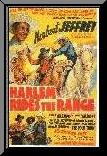About one in six cowboys on the great 19th century cattle drives was of African descent. Many were former slaves who had mastered the skills of riding and roping. When the drives ended in the 1880's, many of these cowboys joined Wild West shows. The most notable cowboy of the era was Bill Pickett, who is credited with the invention of bulldogging around 1900. Pickett reportedly developed this event by observing bulldogs as they worked cattle. Imitating them, Pickett began to grab bulls and steers by the horns, twisting their necks, and wrestling them to the ground. He sometimes took hold of their noses with his teeth. In a bloody demonstration held in Mexico City. Pickett actually wrestled a huge fighting bull to the ground, and was jeered by the bullfight fans, who were accustomed to the more graceful efforts of the matadors.
Jesse Stahl
Hall of Fame Rodeo Cowboy
Although even casual rodeo followers know about Bill Pickett, very few are
aware of other early black rodeo greats such as Jesse Stahl. Stahl,an inductee
into the Cowboy Hall of Fame in Oklahoma City, was a noteworthy saddle bronc
rider. Although exceptionally talented, Stahl seldom placed higher than third at
the major rodeos. At one rodeo where he'd clearly bested his competitors, Stahl
was awarded second place. Perhaps to mock the judges, he rode a second bronc
while facing backward.
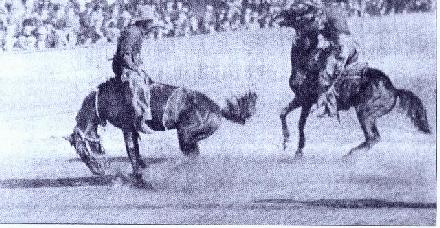 An old photo of Jesse Stahl riding one the hard way! |
Marvel Rogers
All -Around Cowboy
In the 1950's, a top hand emerged from the ranks. Marvel Rogers, who worked
for stock contractor Lynn Beutler for many years, was known as a competent
all-around cowboy. Cleo Hearn, producer of the Cowboys of Color rodeo series in
Texas and Oklahoma, recalls Rogers as an early influence and inspiration to black
cowboys like himself.
"Marvel was a great all-around cowboy, but his specialty was bronc
riding." remembers Hearn. "He was known to ride with a cigar in his
mouth, puffing out a cloud of blue smoke each time the bucking horse touched his
feet to the ground. "In the days of segregated rodeo,they'd hold hat rides.
They'd put money in the hat to see him ride. And the coboys used to say that
those hat rides often paid more than first-place rides in the regular rodeo,"Hearn
said. Rogers was a close friend of legendary all-around champion Harry
Tompkins, who was quoted as saying, "Rogers was the most-robbed cowboy in
rodeo."
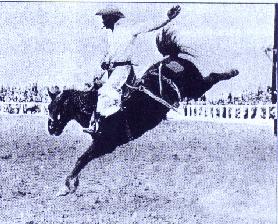
Cigar-smoking Marvel Rogers on Pipe Dream at a Tucson rodeo
In defense of the Rodeo Cowboys Association(now the PRCA), there never was a policy that excluded minority competitors. However, until at least the late 1950s, the lack of black cowboys among the pros, as well as an underlying racism, effectively kept mot blacks from competing with whites. To combat that situation, black cowboys of the 1940s and 1950s formed the Southwestern Colored Cowboys Association, which served as a farm league for cowboys who aspired to become professionals. Many of those cowboys graduated to the professional level, and by the 1960s rodeo became integrated enough to enable blacks to succeed in the pro ranks.
Myrtis Dightman
The most successful black cowboy of the 1960's was Myrtis Dightman, a bull
fighter turned bull rider from Houston. In 1966, Dightman became the first black
cowboy to qualify for the Natinal Finals Rodeo. The following year, Dightman
finished third in the bull riding world standings, as close as he ever came to a
world title. From 1966 to 1972, Dightman missed qualifying for the NFR only once.
Amazingly, Dightman ididn't even pick up a bull rope until the age of 25, and he
was still getting on bulls more than 2 decades later. Dightman was sometimes
compared to Jackie Robinson. Although he wsn't the first black to compete in the
R.C.A., he was the first serious contender for the world title. Though the
cowboys backed the talented athlete, the fans weren't always sure how to take
him. When traveling, Myrtis often slept in his car rather than risk being turned
away from hotels. Dightman took it all in good humor. In the dangerous world of
professional rodeo, he worried more about Brahma bulls than he did about racial
prejudice.
His career helped pave the way for an energetic black bull rider from Los
Angeles - Charles Sampson.
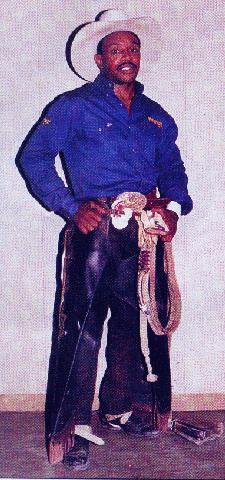
Charles Sampson
The 1982 PRCA World Bull Riding Champion
In his forth year in the pro ranks - 1982, Sampson wrote his name in the PRCA
history books as the first black cowboy to win a world championship. It was
fitting that Myrtis Dightman was the first to offer his hand in congratulation.
Sampson, an unabashed promoter of rodeo, has been a high-profile role model for
aspiring cowboys of all colors and races. In addition to competing at numerous
all-black rodeos and rodeos of color, Sampson has produced a number of
championship rodeo schools and appeared in numerous advertising campaigns.
Currently, Sampson is appearing in a nationwide advertising campaign for Timex
watches. The ad declares, "Bulls have punctured his lungs, broken his
sternum, his ribs, his ankle, his wrist, his fingers, his legs(four times), and
shattered every bone in his face." The ad copy didn't have to mention that
Sampson is a cowboy who takes a licking but keeps on ticking.
In many ways,Sampson exemplifies the black rodeo cowboy of today. "We're
athletes with a love for horses and the cowboy life. Most black cowboys are
athletes, urban cowobys," said Cleo Hearn. This is not a unique situation
among all cowboys today. Although many cowboys still come from rural ranching
backgrounds, an increasing number are growing up in towns and cities.
Dwayne Harbo, Leon Coffee, and Ervin Williams all fit the mold. Coffee and
Hargo both roe to the top in the sport's most dangerous profession-bull
fighting. Hargo grew up in San Bernardino and developed a love for horses and an
admiration for cowboys. As a kid,he looked up to champion cowboys such as Don
Gay, noting that there weren't many black cowboys to serve as role models. But
when he reached the pro ranks, Hargo found a support group. Sampson,along with
legendary bull fighter Wick Peth and 1970 world champion Gary Leffew, signed his
PRCA card. Those impressive signatures lend credibility and prestige to Hargo's
resume.
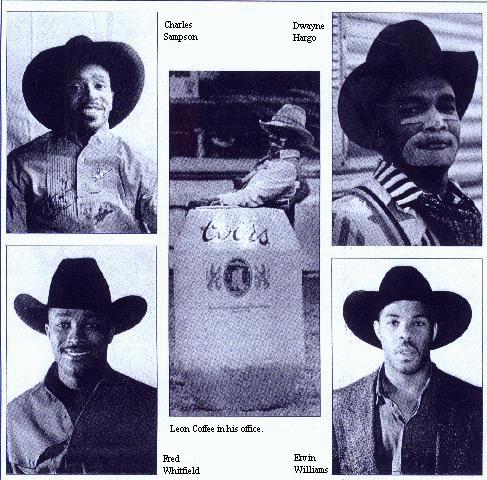
Leon Coffee of Austin,Tex., who was voted 1982 Clown of the Year by the
cowboys, often worked with Hargo to develop the yourger man's skills as an
entertainer. Ervin Williams of Tulsa has carved out an impressive career as a
bull rider, earning four trips to the National Finals in his 7-year career.
Williams captured third place in the world standings in 1989, and is always a
contender in the bull riding world title race.
Among the current crop of black rodeo contestants, Fred
Whitfield, CypressTex., is the most likely to pave the way for a new wave of black
rodeo performers. Unlike the cowboys who have made their mark at the rough-stock
end of the arena, Whitfield has excelled as a calf roping specialist. He burst
onto the scene in 1989, winning Rookie of the Year and Calf Roping Rookie of the
Year awards. A year later, he became the first black cowboy to win the title of
world champion calf roper. "Fred is the most athletic calf roper in the
business - he's got great speed, strength, timing, and accuracy. When he's focused
right and his horse is working good, he's unbeatable," said eight time world
champion Roy Cooper, a close friend and traveling partner.
Whitfield hopes his success encourages other black ropers to compete on
the national level. "There's a lot of good ropers around Houston. Most of
them stay home because they lack confidence and finances to do this full time,"
he said. Thanks to the efforts of rodeo promoters such as Hearn and the
successes of Whitfield, Sampson, and others, that situation may change.
To the Black communities of my generation, the black cowboy was nonexistent," Hearn said, " Presently, of the 10,000 PRCA members, there are only about 120 black cowboys." Hearn says his goal in rodeos of color is to give blacks, Indians, and Hispanics a place to hone their skills and prepare them for professional rodeo. "I want to graduate five or ten cowboys to the pro ranks every year," he said. His efforts and the successes of today's generation of black cowboys should make the future more promising for those coming on.
